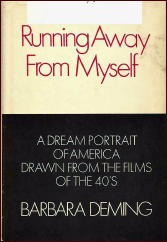Thu 10 Oct 2013
A Review by Dan Stumpf: BARBARA DEMING – Running Away from Myself.
Posted by Steve under Reviews[6] Comments
BARBARA DEMING – Running Away from Myself. Grossman, hardcover, 1969.

Okay, stop the presses. Go out and find a copy of Barbara Deming’s 1969 book Running Away from Myself: A dream portrait of America drawn from the Films of the 40’s. I read it forty-some years ago, and it completely changed the way I looked at movies. I just re-read it, and I think it may do the same for you..
Deming was a writer who deserves to be better known, and her criticism was far, far ahead of its time. (She actually wrote this book back in 1950 and had to wait 20 years to find a publisher.) Running takes a look at the typical films of the 1940s and finds a darker side to them than one would expect from Mass Entertainment — and not just in the films noir.
Why? she asks, do comedies and romances keep throwing complications at the characters? Why do the “success” stories feature heroines who find achievement meaningless? Why are the heroes in Musicals always misunderstood?
The answers are there, and Running puts them across in a style that keeps pulling the reader deeper into a unique vision of the Movies: Deming draws parallels between the prototypes of 40’s films that seem surprising and just right at once:
She looks at Rick in Casablanca and Gregory Peck in Spellbound and sees them both groping for the truth about themselves; Ingrid Bergman in Spellbound and Greer Garson in Random Harvest are painted as Hollywood Ariadnes, bringing their heroes back home; Fred MacMurray in Double Indemnity and George Gershwin in Rhapsody in Blue (and even Eddie Bracken in Hail the Conquering Hero) experience the nightmare of getting everything they want; and her thoughts on movie PI’s like Philip Marlowe and Sam Spade deserve a book all on their own.
Barbara Deming not only understood how films work — F’rinstance: Double Indemnity is narrated by the Fred MacMurray character. So when he’s on his way to kill Barbara Stanwyck and we see her tuck her own gun close by, it’s effectively likely he saw it and walked in anyway. — but she also had the unique gift of explaining them in clear, seductive prose that carries the reader along with it.
This ain’t no abstruse assemblage of academic obfuscation, it’s a fast, enjoyable and thoughtful read that surprises one with the ease of its brilliance. Running works out correlations between Casablanca‘s Rick and Donald Duck, or between The Treasure of the Sierra Madre and the Three Stooges, so easily they seem perfectly obvious. Read this, if only to see her connect a dark, smoky Woolrich film called The Chase (1946) with It’s a Wonderful Life to see what I mean.
And like I say, she wrote this in 1950. So where else can you read about Double Indemnity, Murder My Sweet, Maltese Falcon and The Strange Love of Martha Ivers and never see the word noir?
October 10th, 2013 at 11:57 pm
Barbara Deming’s wikipedia entry:
http://en.wikipedia.org/wiki/Barbara_Deming
This book of hers about the movies is not difficult to find, but many of the ones offered for sale in better condition are rather pricey.
I know. I’ve looked!
October 11th, 2013 at 1:11 am
I not only looked, I bought a copy from an amazon third party seller. Haven’t received it yet but it was inexpensive.
October 11th, 2013 at 4:20 pm
This book sounds very interesting.
I’d never heard of it or Barbara Deming.
Thank you!
The years 1965-1975 were the Golden Years of film book publishing. High quality, intellectual books were put out by the carload, by mainstream publishing. University bookstores were full of them, in inexpensive paperback. I still have many obtained back then.
October 11th, 2013 at 10:25 pm
One thing, tying The Chase with It’s a Wonderful Life was ‘borrowed’ from a novel called Suspects where the author tied It’s a Wonderful Life to the protagonists of most of the major noir films. Nothing against Deming, but it’s been done, and in a bestseller.
October 11th, 2013 at 10:26 pm
Sorry, it seems Suspects got the idea from Deming. Had it backwards. Still, read Suspects if you missed it.
October 14th, 2013 at 6:43 pm
Mike, it occurs to me that there are fewer really good film books these days because the films themselves are so readily available.